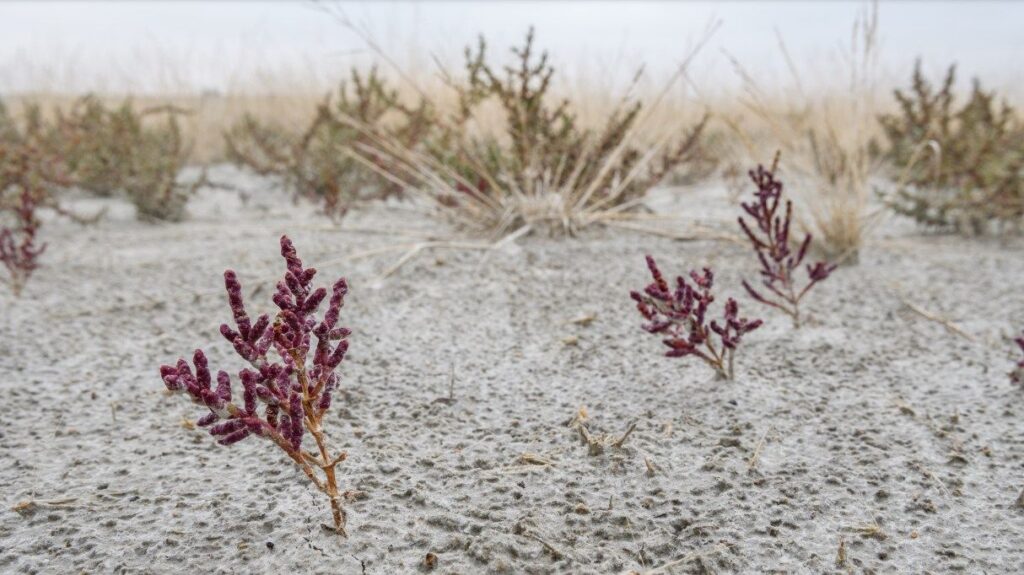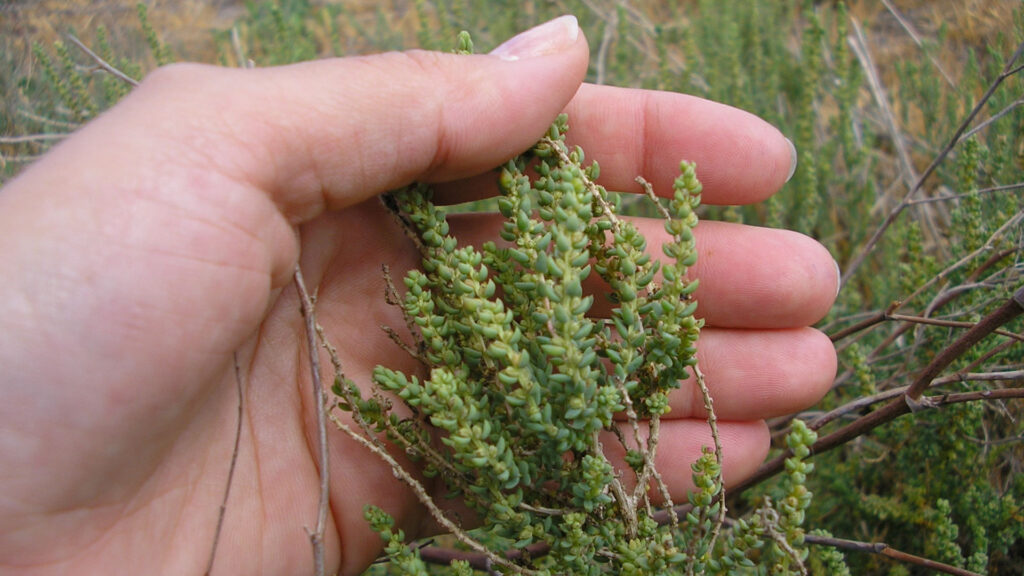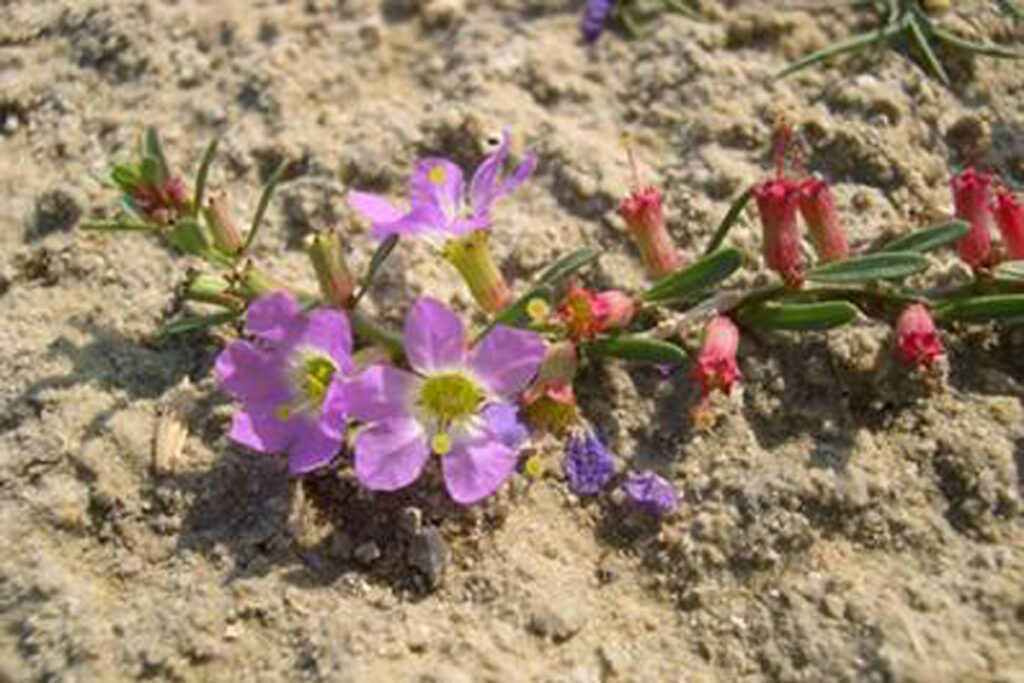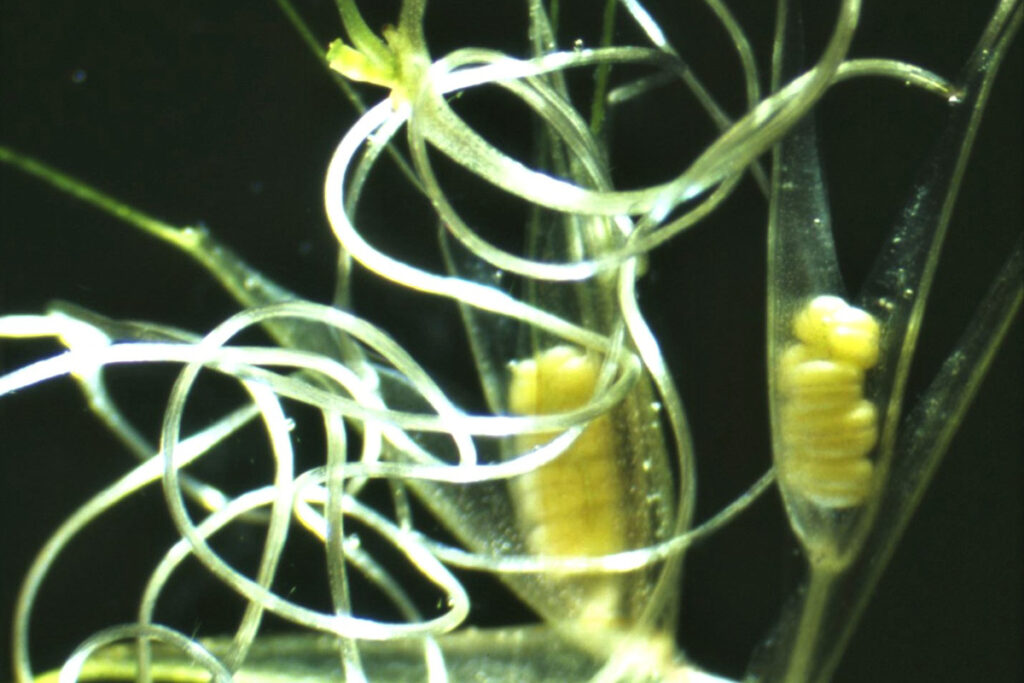La Laguna de El Hito es un humedal salino que se encuentra ubicado en Cuenca, entre la serranía y extensa llanura manchega. Alrededor no hay árboles ni grandes relieves, solo campos de trigo y cebada. Pero algo irrumpe a la vista…, se trata de una depresión del terreno entre los pueblos de El Hito y Montalbo que se inunda durante el otoño y se seca en verano ¡Todo un hito en el camino que merece la pena conocer!
El principal valor de la laguna es su particular dinámica estacional, que condiciona todas sus demás riquezas. Entre mediados de otoño y finales de primavera (en función del régimen de lluvias y temperaturas de cada año) la presencia de la lámina de agua atrae a una gran variedad de especies de aves migratorias e invernantes en este territorio. Esto convierte a la Laguna de El Hito en un punto destacado para la observación ornitológica.
La estacionalidad del agua de la laguna se debe a su clima mediterráneo continental que aporta una precipitación media de 587 mm anuales y un gran contraste de temperaturas, alcanzando máximas de 31,4°C de media en verano y mínimas de –0,5°C de media en invierno.
En verano, la evaporación de la somera lámina de agua, junto a la bajada del nivel freático, permiten observar una blanca costra salina sobre la que destaca el color rojizo de las plantas halófilas. ¡Un paisaje espectacular, casi lunar!


Pero la dinámica estacional no es la única característica singular de la Laguna de El Hito. Los suelos y, por tanto, las aguas de la laguna tienen un alto contenido en sal, que se recicla y se enriquece por los procesos de acumulación y evaporación del agua que tienen lugar en el humedal de forma natural.
La concentración de sales varía de manera estacional y depende de la abundancia de precipitaciones de cada año, oscilando entre los 7.000 μS/cm en los años más lluviosos y 35.000 μS/cm en los más secos. En cualquier caso, se trata de una concentración muy elevada, que puede alcanzar los 50 g/L, un nivel muy superior a la salinidad del mar Mediterráneo, de unos 38 g/L. Por eso, decimos que la laguna es de carácter salino.
La salinidad de las aguas proviene de las sales que componen sus suelos, predominantemente yesíferos y calcáreos. Estos suelos, compuestos también por otros sedimentos como conglomerados, areniscas, margas y limos ricos en materia orgánica, datan del Cuaternario, lo que significa que tienen 2,5 millones de años.
Desde el punto de vista fisicoquímico, las aguas de clasifican bajo un tipo mixto Sulfatado-Clorurado / Magnésico-Cálcico-Sódico. Al disminuir la profundidad del agua y aumentar la sedimentación de las sales, derivan hacia un tipo catiónico magnésico-sódico. Su pH es claramente alcalino, con valores que oscilan entre 8,9 y 10,1.
Además, como no tiene salidas al mar ni a ningún otro río, se denomina laguna endorreica (del griego, “flujo interior”), pues se alimenta de aguas de lluvia y del subsuelo. Ahora sí, podemos describirla con todos sus atributos: La Laguna de El Hito es un humedal salino, estacional y endorreico.
Todas estas peculiaridades derivan en la presencia de una flora y una fauna muy singular, que compone hábitats de alta importancia para la conservación de la biodiversidad europea.

El Hito Lagoon has 7 Sites of Community Importance, 3 of them are keynotes for the conservation of biodiversity in Europe. Find out where they are located and why they are considered ecosystems of High Natural Value HNV.

1150* – Coastal lagoons
This habitat is conformed with very peculiar aquatic plants adapted to high salinity levels, such as Ruppia drepanensis that covers the bottom of the lagoon in years when water keeps until summer, or Zannichellia pedunculata that grows in early spring in alkaline waters.

3140 – Hard oligo-mesotrophic waters with benthic vegetation of Chara spp.
The different species of the genus Chara are specific to transparent, shallow, seasonal and saline waters, i.e., they are endemic to this kind of lagoons such as El Hito. They form underwater meadows of green carophyte algae.

3170* – Mediterranean temporary ponds
This habitat has unique species adapted to the seasonality of the water. The most important botanical value is the jopillo (Lythrum flexuosum), a plant that, when in bloom, covers the lagoon basin with a striking pink color.

1510* – Mediterranean salt steppes (Limonietalia)
These habitats are formed by species that grow farther away from the water, in drier substrates and less tolerance to salinity. The albardine (Lygeum spartum) limonio (Limonium sp.) communities are very important, and they are included in the Regional Catalog of Threatened Species.

1310 – Salicornia and other annuals colonizing mud and sand
Plant communities adapted to soil salinity, in the transition zone between the aquatic vegetation of the lagoon basin and the terrestrial vegetation of saline grasslands and meadows. These habitats are mainly shores, on humid soils with different flooding regimes.

1410 – Mediterranean salt meadows (Juncetalia maritimi)
Associated with coastal lagoons, the saline grasslands of El Hito Lagoon are dominated by herbaceous, annual and perennial plant species such as Puccinellia caespitosa, Artemisia gallica or Elymus curvifolius. In the past times, the different reed meadows were better differentiated than they are today. The farming of these lands, the tilling and the increasing nitrification have modified the old vegetation landscape.

1420 – Mediterranean and thermo-Atlantic halophilous scrubs
Perennial vegetation developed on muddy soils with fleshy plants such as Suaeda vera or Suaeda splendens, typical of saline areas.
Since 2021, the Laguna de El Hito benefits from the LIFE Program, the only European financial instrument dedicated exclusively to the environment and climate action, through the LIFE20 NAT/ES/000035 – LIFE EL HITO Project. This project aims at the recovery and expansion of priority habitats and unique species of the Natura 2000 Network site Laguna de El Hito, halting their deterioration and improving their conservation status.
* Priority habitats are those that require the greatest attention, as they are fundamental for the conservation of European biodiversity.
The species that develop in the Natural Reserve are conditioned by the unique characteristics of the soils and waters of the ecosystem, which in turn derive from its geomorphological, edaphic and climatic characteristics. Thus, there are mainly halophilic species, which tolerate different levels of salinity and humidity present in the lagoon’s soils. Many of the species are endemic to this type of ecosystem (endorheic, seasonal and saline wetlands) or are typical of ecosystems with maritime influence. Due to this high level of specialization, some of these species are in different categories of threat, due to the scarcity and reduction of their habitats.
Depending on their levels of adaptation to salinity and the presence of water, the species are distributed in different areas of the Nature Reserve, more or less linked to the flood zones. However, because it is a seasonal wetland, whose depth fluctuates according to the volume of rainfall, the vegetation is subject to different flooding conditions each year. This mainly influences the development of aquatic vegetation and that which develops in the partially flooded soils. Thus, it is common for the species of some plant formations to mix, especially the seasonal ones, and also the perennials when there are several dry years in a row.
The botanists of Fundación Global Nature have identified 83 plant species in the lagoon environment, of which 45 are specific to this type of habitat and 9 are included in different catalogs of endangered species.
Studies on the evolution of vegetation cover in the lagoon environment show that in the period from 1978 to 2000 approximately 33% of the natural vegetation was eliminated, being replaced by rainfed crops. These processes of tilling and elimination of vegetation cover have caused an increase in the dragging of sediments into the lagoon basin, accelerating and increasing its siltation.
Some of the most representative flora species of El Hito Lagoon Nature Reserve are:

Lygeum spartum
The famous albardine, used for weaving tools and baskets, has a high ecological value as a soil protector. In addition, it shelters steppe birds such as the red-legged partridge, the black-bellied sandgrouse or the stone-curlew.

Microcnemum coralloides
A plant of the Chenopodiaceae family, it has a high chorological value. No larger than 25 cm, in summer it acquires reddish colorations that stand out against the white saline crust of the wetland. It develops in isolated populations mainly in salt marshes of the interior of the Peninsula with continental climate, dry and sunny.

Lythrum flexuosum
It stands out as the greatest botanical value of the lagoon. This plant lives in brackish grasslands that border the seasonal lagoons, where the soil is flooded in spring and dries out in summer. The most special thing about this plant is that it has a vecera flowering, that is, it only flowers when certain conditions occur that are not known in detail. It is not possible to predict its flowering, nor does it occur every year, but when it blooms, it covers the lagoon floor with a striking pink color.

Tolypella salina
This species of saline plant is threatened with extinction in the Iberian Peninsula, and has not been recorded in El Hito Lagoon since 1986.

Ruppia drepanensis:
Perennial aquatic herb that needs to live submerged, so it only develops in especially rainy years when the water sheet does not disappear. This species constitutes the habitat of numerous aquatic insects of great interest for the conservation of the space.

Chara sp.:
Several species of the genus Chara, aquatic plants specific to clear, shallow, seasonal and saline waters, grow in the lagoon.

Limonium sp.:
In El Hito Lagoon we find a great variety of species of this genus. Among them, the Limonium longebracteatum, a La Mancha endemism that inhabits dry gypsum plains of the interior of the peninsula, or Limonium soboliferum, a rather mysterious plant that does not produce seeds and has been located only around El Hito Lagoon, in the province of Cuenca.

Lepidium cardamines
Terophyte endemic to the center of the Iberian Peninsula, annual or biennial and even ephemeral, which inhabits the albardine fields, in gypsum and saline areas and even in nitrified places. The best populations are distributed by the Alcarria Conquense and the south of Madrid and in the surroundings of the wetlands of La Mancha.
As we have already mentioned, El Hito Lagoon is located in a typically La Mancha steppe environment, formed by fields of cereal, sunflower and leguminous plants. In these herbaceous rainfed crops, steppe birds thrive, a group of species that find in extensive agriculture (that which focuses on taking advantage of the natural resources offered by the land) a safe place for nesting and shelter.
Among them we find the famous great bustard, the heaviest flying bird, weighing up to 16 kg, the stone curlew or the little bustard, the only species of the genus Tetrax belonging to the Great Bustard family. All of them endangered bird species in danger of extinction due to the reduction of their natural habitats and the popularity of intensive agricultural practices.
To observe little bustards and great bustards, rather than looking at the sky, we must look precisely at the surface of the fields, because despite being able to fly, they usually prefer to stay on the ground. Soaring through the skies we find those who are undoubtedly the masters of the winds and the air, the most experienced flyers, the birds of prey, great aerial hunters that dominate both the day and night skies. With diurnal hunting habits, the lagoon environment is dominated by harriers: marsh, hen harrier and Montagu’s harrier (all belonging to the genus Circus). At night, the short-eared owl, the barn owl or the little owl take over.
Steppe birds and raptors viewed in El Hito Lagoon:
After crossing the steppe lands and the skies of La Mancha, we arrive at the aquatic environment of the lagoon, where we find a great wealth of birds, the most visible and striking, present when the lagoon has water and is at its maximum splendor. These birds are adapted to feed and walk in the flooded areas. If we pay attention to their anatomy, observing the shapes of their legs and beaks, above all, we will understand why each one moves where it moves and eats the way it eats.
Anatidae are basically ducks, completely linked to the aquatic environment, with webbed feet for swimming, waterproof plumage and a flat bill suitable for filtering the water and feeding on the elements that float in it. We can highlight the common shelduck, the northern shoveler, the red-crested pochard the gadwall or the mallard, which make the lagoon shine with their bright colors.
Looking at the silty soils on the shores of the lagoon we find the shorebirds(which prefers silty or muddy places). With their long legs and beaks they walk without difficulty and find food easily in these muddy soils. The pied avocet, the ruff, the bastard sandpiper, the European golden plover or the stilt are some examples of these precious animals that enrich the biodiversity of the fauna of El Hito Lagoon.
We cannot forget to mention the famous wading birds, so common and striking in these aquatic environments. Armed with their long legs, they manage to have a wide view of the water without having to wet their plumage, while their long necks and special beaks allow them to feed on the crustaceans in the waters. We find such unique species as the great flamingo or the european spoonbill, named after its curious beak.
The crane, the main attraction of the lagoon
Among all the wading birds of El Hito Lagoon, it is worth making special mention of what is undoubtedly the jewel in the crown, the flagship species and ambassador of the lagoon: the crane. The common crane (Grus grus) is a bird with grayish plumage, about one meter high and two meters in wingspan. Its most striking characteristics are its long legs and neck, which give it a slender and stylized appearance. We can identify it without fear of being mistaken (there are 15 species of cranes in the world) by the intense red pileus on the top of its head, devoid of feathers.
El Hito Lagoon is one of the main wintering and migratory sites of the common crane in the Iberian Peninsula. In the wettest years, nearly 10,000 individuals can be counted. On their migratory journeys to the pastures of Extremadura and North Africa, the cranes stop at El Hito Lagoon at two times of the year, although part of the population remains there throughout the winter: they find food in the cereal fields of the La Mancha steppe and a resting place where they can recover their strength by using the lagoon as a roost.
Cranes cross our skies twice each year on their migratory journeys. First, when the weather smells of spring and the climate begins to be pleasant, the cranes fly from Africa, where they have spent the winter, to northern Europe, because they have an important mission: to reproduce. It is there that they have their breeding areas and find everything they need to feed and raise their chicks, where they grow during the spring and summer gaining strength to undertake their first journey in community. That is why we can see (and hear!) them crossing the skies and resting in El Hito Lagoon between the months of February and March. Secondly, when autumn warns and winter threatens cold in northern Europe, the cranes, with their chicks grown, undertake the return to warmer areas, to enjoy milder winters in northern Africa and some parts of southern Europe, such as Gallocanta lagoons in Aragon, other La Mancha lagoons and pastures of Extremadura, where temperatures are more pleasant and there is greater availability of food. That is why they can be found in El Hito Lagoon between the months of October and November.
The crane is a gregarious bird that flies in flocks in order to find protection in the strength of the group. It is common to find these birds flying in their characteristic “V” formation, which allows them to save energy. The strongest individuals that are placed and take turns in the most forward positions, breaking the air resistance at the apex of the “V”, so that a wake is generated that pushes and allows the other individuals to fly more easily.

Although it may not seem so, the environment of El Hito Lagoon is very populated. In addition to the people of El Hito and Montalbo, if we sharpen our eyes with a more focused eye for detail, if we stop our thoughts and listen carefully, we can perceive the amount of invertebrate fauna found in this ecosystem. El Hito Lagoon has a lot of different insect families, (grasshoppers, crickets, cicadas, butterflies, beetles, damselflies or dragonflies). This means that the total number of invertebrates in the lagoon is much larger and unknown.
In the lagoon waters, species with a high tolerance to salt, such as the “Camaroncillo duende” (Branchinecta orientalis), small crustaceans of vital importance in the food pyramid of the lagoon ecosystem, develop almost invisibly. These shrimp are present in the salt steppes of Hungary and Mongolia and in some wetlands of La Mancha such as El Hito Lagoon.
Also associated with the water, we can observe a multitude of odonates, dragonflies and damselflies that attract attention with their bright metallic colors. If we are lucky, we can see the curious way in which they mate or the unique flight of dragonflies reminiscent of a helicopter. Sometimes it is even possible to hear them cutting through the air as they fly past us.
Already on land, we can find a large number of other insects, among which there are unique species of this type of salt lakes and, therefore, of great interest. It is worth mentioning the “Cigarrón de La Mancha” (Roeseliana oporina), a type of cricket recently rediscovered by a team of researchers from the National Museum of Natural Sciences of Madrid (MNCN-CSIC) and whose conservation responsibility is all ours, since it only lives in El Hito Lagoon. Refugees among the albardine fields we also find other orthoptera (crickets, grasshoppers, cicadas and locusts), such as the Italian locust or numerous and varied grasshoppers.
Coleoptera (beetles) form the most abundant and diverse group of the animal kingdom, and as it could not be otherwise in the lagoon we find endemic species that are only present in the Iberian Peninsula.
The province of Cuenca has a great diversity of butterflies. In the lagoon, we can find specimens of Euphydrias aurinia, known by “Maiden of the honeysuckles”. This butterfly has an increasingly reduced area of distribution, finding in the Iberian Peninsula some of its European populations.
All these invertebrates in turn serve as a source of energy and food for many vertebrates, small mammals such as bats or hedgehogs, which find in the lagoon a feast of insects. In addition to these, there are many others, such as rodents, weasels, dormice, foxes, rabbits and hares.
But not only hair is not the only thing, we also find scaly animals, reptiles that hide in the soil and vegetation, highlighting such curious species as the Iberian skink (which has such tiny limbs that can be confused with a snake), ocellated lizards that paint the white of the lagoon with its bright green and blue ocelli, many lizards and geckos, as well as elegant snakes.
Finally, on the shores of the lagoon, and especially if we approach at dusk, we can hear the croaking of toads and frogs, amphibians that live between water and land, and are an important part of the night soundtrack of the lagoon.
El Hito Lagoon is a place very rich in vertebrate animal species, with at least 101 different species of mammals, reptiles, amphibians and birds, the latter being the most numerous group. Of these 101 species, 22 are classified as seriously threatened with extinction: 6 “Endangered” and 16 “Vulnerable” by the IUCN, although at the regional level the vast majority are in a vulnerable state.

The main economic activity of the El Hito Lagoon Nature Reserve has been eminently agricultural and livestock, as is usual in La Mancha plains of La Manchuela and La Alcarria. The old information describe a dry farming more diverse than the current one, developed based on cereals (such as rye and oats), and leguminous plants (such as lentils, chickpeas, vetch or yeros) and destined to complement the family or livestock feeding.
The livestock in this area has been mainly sheep and goats, although there are references of cattle in the past. It is also likely that other domestic and working animals were part of daily life in these villages, such as chickens, donkeys and mules. Their presence was essential to ensure the fertility of the land and the balance of the forest systems: from the animal traction of the draught animals to the cleaning of the forest through the grazing of the herds.
Among the most typical artisan uses of the environment, we have described the use of natural fibers from the lagoon’s vegetation for braiding and the elaboration of tools. The case of the albardine (Lygeum spartum) stands out, which was used to make seats, shoes or baskets, like the “atocha” or esparto grass (Stipa tenacissima) in other regions; and the ceacillo (Agrostis nebulosa), for the elaboration of little brooms.
These uses are mentioned in the quotations on El Hito Lagoon that appear in historical documents, and which provide a series of data on the relationship of the populations of this area with the lagoon.
The earliest citation to which access has been obtained dates from the 18th century, although there is evidence of earlier citations. It appears in the manuscript of the Geographical Dictionary of Spain, which includes a series of questions posed by Tomás López to the cities, towns and villages of the Kingdom. These questions are answered for the enclave that concerns us in April 1787, with the following content (in spanish):
“…ay también una famosa Laguna, al medio día, que divide a El Hito de Montalbo, de una lengua de circunferencia, y un guarto de legua de trabesía, ó latitud; su profundidad es de vara y media por lo más hondo; sus aguas son llovedizas, pues es tan fuerte su piso qe aunque no hay piedra, no traga agua dicho terreno; y aunque pasen caballos no se llenan de lodo. Los años lluviosos no se seca, pero sí los qe no son, á fuerza del calor del Estio. Llamase famosa, por la diversidad de aves qe concurren á ella, pues viene aves marítimas qe se llaman Flamencos, de altura de dos varas y grandor de un pabo, con pluma encarnada, y blanca, las más finas para plumaje. Abunda dicha laguna de muchas anades, cercetas, oncejo marino, en tal abundancia qe la cubre, y su nombre es: “LA LAGUNA DE MONTALBO “.


As we can see, in the past it was the town of Montalbo that gave its name to the lagoon, while nowadays it is known by the name of El Hito. With the permission of both, we can interpret this anecdote as a sign of the sharing and competition that characterizes all sibling relationships, in this case, given by the lagoon.
This manuscript also mentions the Royal Saltpeter Factory of Montalbo, pointing out that due to the salty and sulphurous soil, the Montalbo factory was superior to others.
We also find references to duck hunting in historical references. Today, there is an extended ban on hunting in the entire protected area of the lagoon that protects all of its biodiversity. For the development of this activity, controlled, there are two small hunting preserves in Montalbo and another small and large hunting preserve in El Hito.
Industry: Industry is not very significant in the region. It is focused in the agricultural sector, with a cereal calibration facility, a winery in El Hito and a butcher’s shop associated with a small slaughterhouse in Montalbo.
Assuming human intervention in a modified natural environment, but in equilibrium, this is only a slight glimpse of the interaction of the inhabitants of El Hito and Montalbo in the environment, since all their daily activities were or were possible thanks to some use of the elements of the environment.
However, the intensification of agricultural techniques has resulted in excessive ploughing, sometimes to the very limit of the flood zone, and the dragging of phytosanitary products into the lagoon basin. Both have been accelerating processes of eutrophication and siltation of the lagoon, in a context of low remuneration for farmers, increased global competition and loss of autonomy
El Hito LIFE Project seeks to promote sustainable uses in the environment of the Natural Reserve, proposing collaboration strategies with the farmers of these municipalities. The objective is to move towards models of interrelation that guarantee the custody of the territory, promoting a type of economic development in the region that is compatible with the conservation of the values of the natural space. Some of these strategies are:
